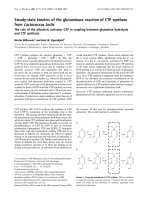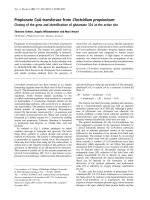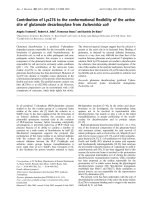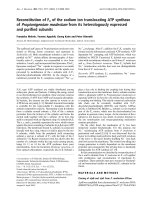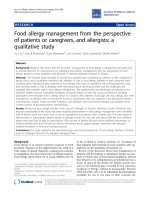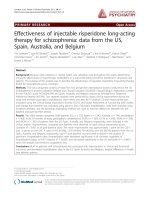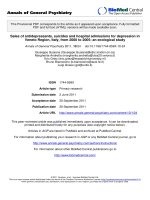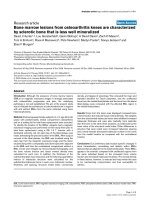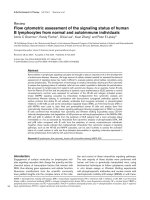Báo cáo y học: "Histone tales: echoes from the past, prospects for the future" ppt
Bạn đang xem bản rút gọn của tài liệu. Xem và tải ngay bản đầy đủ của tài liệu tại đây (396.05 KB, 3 trang )
It has been 150 years since Charles Darwin described in
his seminal work On the Origin of Species how descent
with modification and natural selection could explain the
diversity of life. When Mendel’s theory of inheritance was
rediscovered in the early 1900s and verified to be
consistent with natural selection, evolutionary biologists
adopted genetics as the central pillar of the Modern or
Neo-Darwinian Syntheses and committed to genetics as
the center of their explanatory paradigm. With Darwinism
becoming widespread, the discovery of the DNA double
helix structure by Watson and Crick was hailed as finally
delivering the long-sought hereditary mechanisms for
evolutionary theory.
e concentration on genetics has now lasted almost a
century and, despite some claims to the contrary, evolu-
tionary genetics established the consistency, though not
the sufficiency, of genetics and natural selection to
explain evolution. We are now coming to realize that
gene-centric theories of evolution are limited in their
scope [1,2]. is shortcoming has been addressed by the
life history theory, which analyzes the evolution of
whole-organism traits (in particular phenotypic varia-
tions such as size at birth, growth rates, age and size at
maturity, clutch size and reproductive investment,
mortality rates and lifespan) on the basis of the criteria
that life histories are shaped by the interaction of
extrinsic and intrinsic factors. It states that extrinsic
factors are ecological impacts on survival and repro-
duction and that intrinsic factors are tradeoffs among life
history traits and lineage-specific constraints on the
expression of genetic variation.
Although life history theory can offer detailed answers
to the question of why phenotypes are different, it does
not attempt to understand the mechanisms that mediate
and integrate these differences. ree recent studies [3-5]
take us, however, an important step forward in this
direction. ey build on the nematode Caenorhabditis
elegans as a unique model system for studying animal
survival strategies and the environmental regulation of
life histories. C. elegans is a rapidly growing worm and its
entire life cycle, from an egg to an adult, takes only
3.5days in the presence of abundant food at 20°C. After
embryogenesis, C. elegans progresses through four larval
stages (L1 to L4) before becoming an adult (Figure 1).
When developing C. elegans larvae sense the pheromone
daumone (a mixture of ascarosides), they enter into a
physiologically specialized state - the dauer state - that is
capable of long-term survival.
Genetic studies have identified various signaling
systems as critical regulators of dauer state, including
insulin and transforming growth factor-β signaling. More-
over, two G-protein-coupled chemoreceptors (srbc-64
and srbc-66) have been recently identified to mediate the
effect of the dauer hormone [3]. Although the dauer stage
is a well-known option for escaping unfavorable
conditions for young larvae, animals at later stages use
different means to cope with the environment. In fact,
the dauer stage of C. elegans is not only a survival
strategy, but also induces adult reproductive diapause, a
delay of reproduction that results in increased longevity
and protection of germ stem cells. Adult diapause entry
and exit are regulated by the gene nhr-49 [4], which
encodes a nuclear hormone receptor, and daf-12, another
member of this gene family, controls dauer formation.
Together with previous work, these two studies [3,4]
deepen our insight into critical regulatory nodes of larval
dauer and adult diapause, although they do not reveal the
integrated responses that presumably underpin these
states. In a recent study, however, Hall and coworkers [5]
report a refreshing approach to the topic by performing a
series of well-designed experiments to unravel the
complexity of the gene-environment dialog for different
life histories at an organismal scale. Genome-wide
expression profiling for control and postdauer whole
Abstract
Recent studies of the nematode dauer state provide
new insights into epigenetic processes that underlie
cellular memory.
© 2010 BioMed Central Ltd
Histone tales: echoes from the past, prospects for
the future
Chris Murgatroyd and Dietmar Spengler*
R E S E A R C H H I G H L I G H T
*Correspondence:
Department of Molecular Neuroendocrinology, Max Planck Institute of Psychiatry,
Kraepelinstrasse 2-10, D-80804 Munich, Germany
Murgatroyd and Spengler Genome Biology 2010, 11:105
/>© 2010 BioMed Central Ltd
adult animals led to the identification of over 2,000 genes
that were significantly upregulated in either group (one
of the largest groups being associated with reproduction).
By extending their analysis to dauer, postdauer and
control larvae they could further show that the altered
gene expression observed in postdauer animals arises
from multiple regulatory mechanisms acting during the
dauer stage (164 genes), on subsequent resumption of
repro ductive growth (143 genes) or at both stages (400
genes). Functionally, these changes correlate with a longer
mean life span and a larger brood size in the postdauer
stage animals. Although the authors [5] do not directly
demonstrate which of these genes causes the phenotype,
they conclude that differences in life history have been
hard-wired at the level of persistent changes in gene
expression patterns. So what are then the molecular
mechanisms that couple differences in life histories to
gene expression patterns that drive the development of
different phenotypes?
Epigenetic regulation of gene expression allows the
integration of intrinsic and environmental signals in the
genome and can facilitate the adaptation of organisms to
changing environments through alterations in gene
expression [6]. DNA methylation is one of the most inten-
sively studied epigenetic mechanisms, with an estab lished
role in development and cellular differen tiation. However,
the global DNA methylation pattern seen in vertebrates is
by no means ubiquitous among eukaryotes. Several well-
studied model systems, including C. elegans, have no
recognizable Dnmt-like genes and are devoid of DNA
methylation. is prompted the authors [5] to investigate
whether, alternatively, histone modifications could bridge
the dauer state to a lasting transcriptional record.
Genome-wide analysis by chromatin immunoprecipi ta-
tion followed by sequencing (ChIP-seq) showed that
chromatin marks associated with euchromatin (pan-
acetylation of histone H4, H4ac, and trimethylation of
histone H3 at lysine 4, H3K4me3) were decreased in
postdauer animals, despite similar overall gene
expression levels, and localized primarily to highly
expressed genes [5]. In contrast, repressive chromatin
marks (H3K9me3 and H3K27me3) showed similar levels
in control and postdauer animals. In support of a func-
tional role for these changes, active but not repressive
marks correlated positively with gene expres sion.
Importantly, this global histone signature also extended
to the genes that were altered in postdauer animals.
Euchromatic marks were mainly reduced at upregulated
genes but less at downregulated ones and correlated
positively with gene expression. Intriguingly, however, no
correlation was observed between the fold change in
gene expression and the chromatin modifi cation profiles
between control and postdauer populations.
Together, these data show that exposure to dauer state
leaves a deep trace on the epigenome, which manifests as
a genome-wide loss of active chromatin marks. Given
that this kind of cellular memory primed only some but
not all genes for subsequent changes in their expression,
additional locally acting mechanisms seem to be at work.
In a nutshell, the dauer-induced chromatin modeling did
not lead per se to changes in gene expression but paved
the way for these changes on a site-specific scale.
To test the hypothesis that dauer-induced chromatin
changes can act as a ‘pacemaker’ for changes in local
transcription, the authors [5] studied a series of C.
elegans mutants with defects in different components
controlling chromatin assembly (histone deacetylases,
chromatin remodeling ATPase, chromatin associated
proteins, and others). Although these mutations did not
interfere with dauer formation, they affected to varying
degrees and specificity the dauer-induced regulation of
two genes that were studied as examples (the Major
Sperm Protein family member gene msp-64, and the
choline/carnitine O-acyltransferase gene W03F9.4). ese
data strongly suggest that dauer-induced chromatin
remodeling is necessary, but not sufficient, for cellular
memory formation in C. elegans.
Collectively, the results from Hall and coworkers [5]
suggest a two step model in the formation of a cellular
memory underpinning life history traits in C. elegans
(Figure 2). In this model, global changes in histone
modifications exert a universal gatekeeper function by
preparing the ground for rewiring developmental
trajectories in response to environmental stimuli.
Although these chromatin marks seem to be central to
the formation of a kind of rudimentary memory, they do
not suffice to control the overall transcriptome. However,
Figure 1. The life cycle of C. elegans. Under favorable conditions
animals pass through direct development to adulthood in as little
as 3 to 4 days. In response to harsh environmental conditions, such
as food shortage, crowding or high temperatures, animals can enter
into an arrested dauer stage.
Murgatroyd and Spengler Genome Biology 2010, 11:105
/>Page 2 of 3
by resetting the epigenomic activation pattern, they
facilitate further downstream, currently unknown, mecha-
nism(s) to index genes in a site-specific manner. ere-
fore, dauer-induced genome-wide changes in histone
modifications seem to be permissive for the rewiring of
gene expression patterns that serve to consolidate
memory formation.
Future studies are necessary to elucidate in greater
detail how permissive (global) and directive (site-specific)
mechanisms are interconnected in cellular memory
formation and whether distinct environmental signals
operate at these different scales. e findings [5] also
provoke the question of whether such graded memory
formation in response to dauer state reflects a general
principle of life history trait formation in C. elegans. If
this is the case, it may represent an ancient and possibly
conserved mechanism that applies in concert with DNA
methylation to other eukaryotes and could underpin
processes in cellular memory of profound socioeconomic
and medical implications [7,8]. In any case, the availa-
bility of powerful tools such as ChIP-seq and RNA
interference make C. elegans an excellent model organism
for shedding new light on the role of chromatin in
memory formation and life history traits.
Published: 26 February 2010
References
1. Jablonka E, Lamb MJ: Evolution in Four Dimensions: Genetic, Epigenetic,
Behavioral and Symbolic Variation in the History of Life. 1st edition.
Cambridge, MA: MIT Press; 2005.
2. Cloud J: Why your DNA isn’t your destiny. TIME 2010, 18:49-53. [http://www.
time.com/time/health/article/0,8599,1951968,00.html]
3. Kim K, Sato K, Shibuya M, Zeiger DM, Butcher RA, Ragains JR, Clardy J, Touhara
K, Sengupta P: Two chemoreceptors mediate developmental effects of
dauer pheromone in C. elegans. Science 2009, 326:994-998.
4. Angleo G, Van Gilst MR: Starvation protects germline stem cells and
extends reproductive longevity in C. elegans. Science 2009, 326:954-958.
5. Hall SE, Beverly M, Russ C, Nusbaum C, Sengupta P: A cellular memory of
developmental history generates phenotypic diversity in C. elegans. Curr
Biol 2010, 20:149-155.
6. Jaenisch R, Bird A: Epigenetic regulation of gene expression: how the
genome integrates intrinsic and environmental signals. Nat Genet 2003, 33
Suppl:245-254.
7. Gluckman PD, Hanson MA: Living with the past: evolution, development,
and patterns of disease. Science 2004, 305:1733-1739.
8. Zhang TY, Meaney MJ: Epigenetics and the environmental regulation of
the genome and its function. Annu Rev Psychol 2010, 61:439-466.
Figure 2. The gatekeeper function of histones in cellular
memory. The dauer state of C. elegans induces global changes
in histone marks that are necessary, but not sucient, for the
formation of a cellular memory that governs life history traits. The
dauer-dependent histone signature serves as a kind of rudimentary
memory that prepares the ground for further downstream site-
specic changes in gene transcription, which lead to a consolidation
of the memory process. The epigenetic mechanisms that read
the dauer signature, rewrite local histone marks and control
transcriptional factors that together induce local changes in gene
expression are currently unknown. Ultimately, these transcriptional
events trigger altered developmental trajectories that underpin life
history traits and manifest with distinct phenotypes.
Global histone
signature
Site-specific
transcription
Life history
traits
Phenotype
Consolidation
of memory
Rudimentary
memory
Dauer
Epigenetic
gatekeeper
Epigenetic
readers
& writers
Survival
Time
Postdauer
Control
Murgatroyd and Spengler Genome Biology 2010, 11:105
/>doi:10.1186/gb-2010-11-2-105
Cite this article as: Murgatroyd C, Spengler D: Histone tales: echoes from
the past, prospects for the future. Genome Biology 2010, 11:105.
Page 3 of 3
